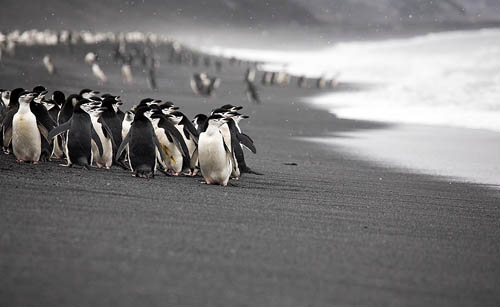“There is no wealth but life”
Why we need a world with more life in it now.
“I tore myself away from the safe comfort of certainties through my love for truth — and truth rewarded me.“
— Simone de Beauvoir
The good news is that there is probably more biodiversity (types) of life on earth than we currently know or even imagine.
The bad news is we are killing it off very fast.
What is biodiversity?
The term biodiversity (a contraction of ‘biological diversity’) was coined in 1985 and popularised by biologist Edward Wilson in 1988 in his book of the same name. Given that the term is only 25 years old, it has gained remarkable traction in everyday life.
Together with Natural Capital, biodiversity is one of the current buzz words in corporate sustainability. Businesses actively engaged with sustainability realise that single issues such as energy use, climate change or workers’ rights are interrelated with others such as water use and biological diversity. As extended scrutiny further illuminates the nether regions of value/supply chains, complex impacts and inter-dependencies are uncovered.
In practice, biodiversity is in trouble in reality and as a concept. The term is very difficult to define, potentially ranging as it does from genes to entire ecosystems. There are two main approaches to categorising biodiversity, the functional and the compositional (as suggested by Callicott et al 1999). Functional approaches consider ecosystem and evolutionary processes, while compositional approaches look at organisms in terms of their populations, species, taxa and other groupings.

The complexity of the term biodiversity means that it is often poorly understood in wider society. But this reflects a wider malaise; in many ways we have lost view of our connections – and dependencies upon – the natural world. Most people view biodiversity as something of nebulous but rather removed value, rather than a way of interpreting the ecosystem which provides us with life. We see ourselves apart from nature rather than as an intrinsic part of it.
This disconnect, in both perception and behaviour is having massive and perhaps unprecedented impacts upon our ecosystem.
What’s the problem?
A range of studies suggest that by whatever measure we use biodiversity is in rapid decline. Uniquely among other species, humans have had a dramatic and globally reaching negative impact upon the number of and abundance of many species.
Many scientists have suggested we are entering the sixth great extinction, a man made loss of species at rates equal to exceeding other great global extinctions we can see in the geological record. Current extinction rates are between 100 and 1000 times the ‘natural’ background rate. Some have suggested this new epoch should be called the Anthropocene.
What is causing this decline? There are a number of interrelated factors, often grouped under the acronym HIPPO (decreasing in importance from left to right).
- Habitat loss – the loss, destruction or large scale disturbance and modification of habitats through clearance for agriculture or development or through fire, modifies ecosystems and removes space and opportunities for species to live.
- Invasive species. Human actions, primarily through trade, or development and population of uninhabited areas helps move plants and animals deliberately or accidentally into areas where they have no inherent predators or other control mechanisms and where consequently they disrupt and damage local ecosystems.
- Pollution – the widest form of pollution impact is through greenhouse gases causing global warming and moving climate ‘envelopes’. Other types of pollution including industrial chemicals, oil spills, plastic particles and pesticides interfere with physiological and biochemical processes and poison and weaken organisms and their ability to successfully reproduce.
- Population – or more precisely the impact of human populations as a driver of the above impacts, is growing as consumption and the related production impacts grow, requiring land use change, land for growing food and further disturbance.
- Over-harvesting occurs when stocks/populations of species are harvested at a greater rate than they can replenish. Different wild fish stocks provide key examples.
Why is it a problem for us?
People, companies and governments often tacitly acknowledge the importance of biodiversity but struggle to make it a priority. Like many other environmental issues this at least in part due to the complexity of the issues and their possible solutions. While there is a crisis with respect to geological and evolutionary timescales this is more difficult to understand and translate into human timescales.
To put it simply biodiversity is a metaphor and an indicator for the natural vitality of life on earth. And earth is our habitat – our only home. Something is going very wrong with where we live and we need to take more notice and (more importantly) more action.
Despite studying the biology of our planet for several hundred years (at least in western science) we still know woefully little about what other life we share the planet with. We still don’t really know how many species there are on earth. The table below headlines what we know using the (normally maligned – but not in this case) Rumsfeld framework:
| Known knowns | 1.2 million species |
| Known unknowns | 8.7 million species* |
| Unknown unknowns | Whatever doesn’t fit our models and assumptions |
* eukaryotes (single or multicellular organisms, their cells have a membrane bound nucleus). Nature 2011
These estimates suggest that a staggering 86% of land species and 91% of marine species remain undiscovered. A further, more worrying, implication is that given the accelerated extinction rates of the Anthropocene, it is highly probable that we are causing the extinction of species before they have been discovered.
Not just for nature lovers
OK – so it’s complicated and we know that our knowledge has gaps, but why does this matter? The main problem outside the field of ecology is one of value – and management. Biodiversity at some level (a level we are struggling to fully understand) is vital to life on earth and we need to value and protect what is important.
It also has another critical dimension – biodiversity loss is generally irreversible.
Because of its importance and the fact that the main pressures upon biodiversity stem from industrial production processes, poverty, globalization and social injustice, the solutions must be enacted by a far larger group than biodiversity savvy ecologists or biologists.
Biodiversity & ecosystems – bridging the knowledge gaps
Because we don’t even know how many species there are, it is difficult or impossible to assess how much diversity we can lose while maintaining the ecosystem services we rely upon for survival.
Our knowledge is incomplete; biodiversity encompasses the twin components of unknown variety and unknown value.
Yet despite this lack of knowledge we understand some important principles:
- We share our origins, DNA and environment with other species – they are part of our ecology/we are part of theirs’.
- Our ecological understanding is incomplete; we don’t yet know what the implications of modifying species abundance and distribution globally will be on the operation of ecosystems and the ‘products’ and ‘services’ they provide to us.
- Species provide a valuable genetic resource, to support viable populations of species and for human exploitation.
- Removing species from earth now and for the future represents a massive future ‘opportunity cost’
The ecosystem approach has been developed as a model and a metaphor to help build understanding of, and provide a framework for, the value the environment has for humans. This is of course vitally important, after all it’s us that’s causing all the damage. However, this is a very anthropocentric view and should be recognised as such.
The arguments above are utilitarian and based upon enlightened self-interest. Some argue that biodiversity, nature also has:
- an intrinsic value, apart from human existence and values; and that
- humans have a stewardship responsibility, based upon our unique position of power and/or a spiritual/religious basis to preserve and maintain life.
Whether justifications reside in either or both of these categories, there are compelling practical and moral reasons to act.
The need for dramatic action
We need a more sophisticated approach to our understanding of biological value, more strongly related to its intrinsic ecological value and to its functional value to us as a species. We are likely to need ecosystems with what may currently be described as perhaps low to medium biodiversity that provide us with food, fuel and other materials. In densely populated landscapes such as Europe, these will provide a range of benefits to humans and the natural environment. They are likely to offer more niches, structural and spatial heterogeneity than current intensive agricultural systems – and hence greater biodiversity. They are likely to be more resilient to climate and other disruptions while providing greener, more pleasant, places to live for us and the other species we share the landscape with.
However, we have no idea if this approach goes far enough. To paraphrase E. O. Wilson from his UK address at St Paul’s Cathedral (2014):
“We are playing with the very stuff of life without understanding what it is or its value to us or the rest of life on earth”.
To meet long-term sustainability and human development goals we will need to grow more food and further develop industrial supply lines based upon biological inputs rather than less sustainable mineral based inputs.
Perhaps it’s time to return to E.O. Wilson and his conclusions based upon a lifetime of study and contemplation. His vision and solution is clear, if ambitious. He suggests that half the world should be available to humans and the other half to the other 8 million species. At first this sounds unbelievably radical and hugely impractical. But it is based upon sound logic (“never has the precautionary principle been more important”) and provides an inspiring vision. If we want to meet long term human development goals we must do so on a healthy planet and one that we can share with the other 8 million plus species of unknown future value to us and the stability of our ecosystem. We have to reinvest in our home and our integral place within it rather than considering ourselves utterly apart.
Are you looking to develop or exceed ambitious sustainability goals? Contact our sustainability consultants for an exploratory chat without obligation.
Chat with a sustainability consultant
Leave a Reply